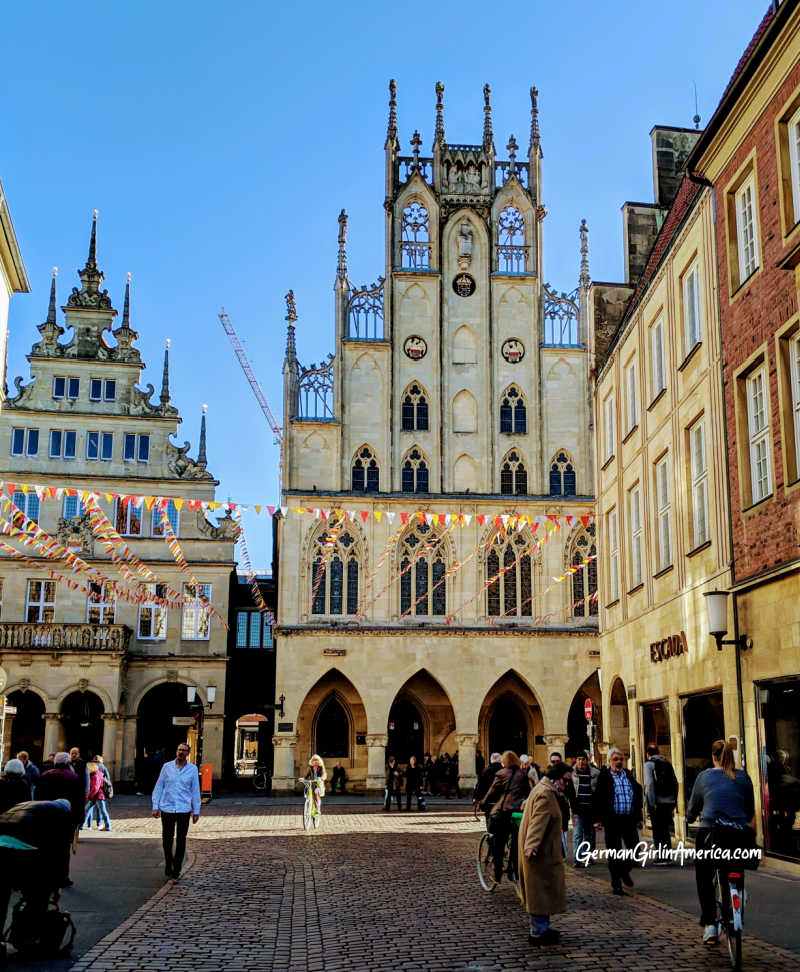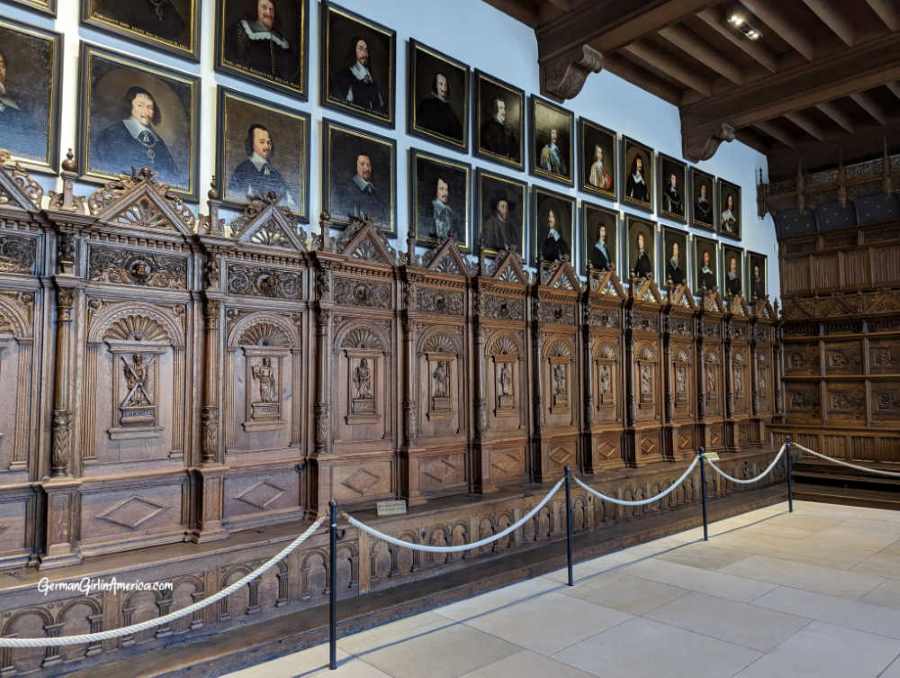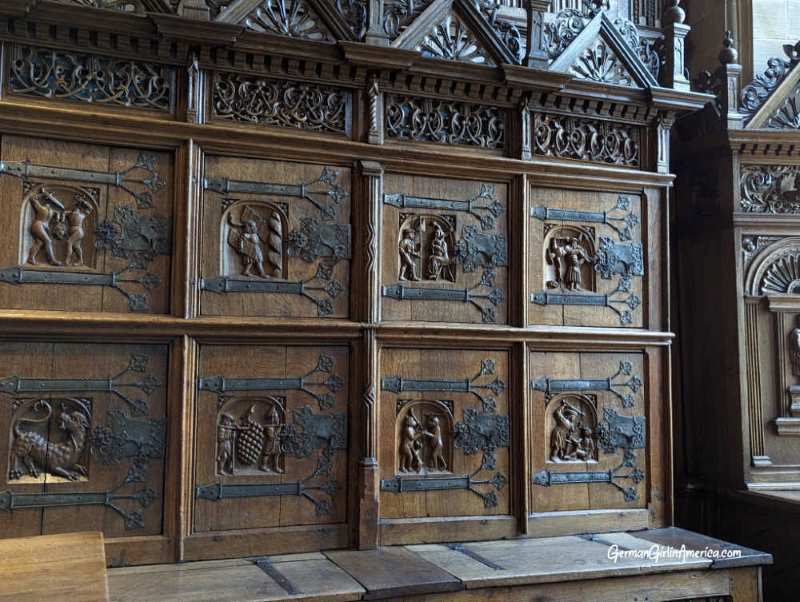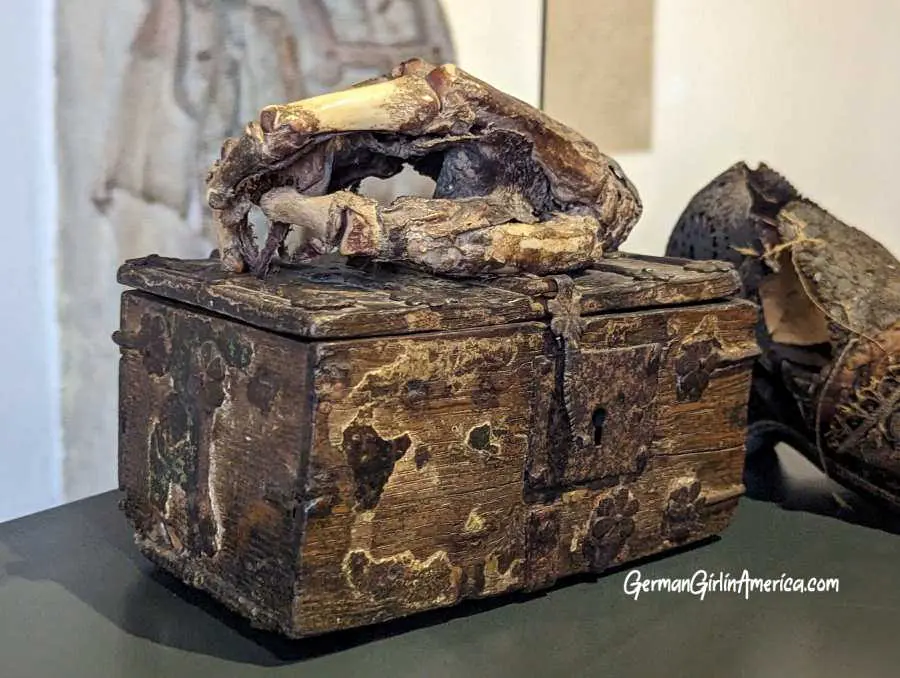Through the Arches, up the front steps, and inside the Historic Rathaus along Münster’s Prinzipalmarkt you’ll find the Friedenssaal, Hall of Peace. The room has remained essentially unchanged for the past 375 years, from the time when envoys across Central Europe arrived to debate and hammer out details for the Treaty of Westphalia and Peace of Münster which ended the devastating Thirty Years War. And not just the Thirty Years War, negotiations to end the Eighty Years War between the Dutch and the Spanish mainly took place in the room. The Treaty of Westphalia or Peace of Westphalia was a series of treaties, and the pages were signed both in Münster and down the road a bit in the partner city of Osnabruck. Beyond ending the bloodshed, the treaties established the right of each state to have exclusive sovereignty over its territory.
October 24, 1648, marked the first time European wars ended in negotiations, and it stripped power from the Holy Roman Empire by establishing sovereignty. (This is a big deal.) The Friedenssaal should be a stop on any visit to Münster.
PLUS! It’s not just a room and a bunch of signatures on a treaty. You can lure the teenagers in by telling them that there is a mummified hand in the room.

Friedenssaal Münster
“It is a gloomy, solemn place.
Many pictures gaze down with yellowed faces….” Levin Schücking
(Truth is, despite Levin Schücking’s despair, the room is actually quite bright since one of the walls is mostly windows.)

The pictures, paintings actually are of the ambassadors and the sovereigns involved in negotiating the Peace of Westphalia in this room. The Emperor Ferdinand III, King Louis XIV of France, King Philip IV of Spain, and 32 ambassadors… all hung in order of importance. (Note that although Count Oxenstierna of Sweden is on the wall… Queen Christina of Sweden is NOT. Most likely because she signed the treaty that was created in Osnabrück).
The raised area at the front of the room is reserved for judges when the room is used as a council chamber. Remember, the room was originally used as a courtroom. The late gothic wood carvings hide 22 document cupboards. She’s hard to see in this photo… but the Madonna on the chandelier is known as the “Queen of Peace”

Each of the panels tells a different story. You see men fighting over a decapitated head… Samson ripping off the town gate… a soldier and jester…
The top far right image shows the women of Weinsberg, the enemy army allowed to take from their town what they could carry, so they carried their men (Anyone see that scene in Ever After?)

The stone fireplace with its figure of Justia reminds you that the purpose of the room is to find and administer Justice.

Tucked under the Fireplace mantle is the Golden Rooster designed by Nürnberg Goldsmith Jörg Ruel. The hollow bird holds nearly a liter of liquid! Tradition states that each Burgermeister of Münster should take part in a special drinking ceremony to the health of the city… and empty the full cup in one go.
Why a rooster? Legend says that at one point in history the city was under siege. The surrounding army was convinced they could starve the people out. When an alderman went to kill his last rooster, it crowed loudly and flapped it’s wings and flew up to the Aegidius Gate. The army saw it, presumed that there wasn’t a food shortage after all… and went away. The rooster was hailed as a hero, and the alderman was made mayor. (The fate of the rooster is unknown)

And as promised…. a mummified hand…
The strange part about the hand is not that there is a HAND just lying there on a box…. it’s that no one knows exactly who the hand belongs to. Does it belong to one of the Anabaptists who took over the city in the 16 century? (more about that here-Anabaptist Rebellion). Or is it the hand of a Notary who forged documents?
Most likely, it belonged to a murder victim. 500 years ago, anyone accused of a crime had to face his accuser…. but if the victim is dead, it’s sort of cumbersome (and probably a little smelly) to have that person in the room. A hand would satisfy the require of being present…without causing extra work.

Before the Friedenssaal was the Friedenssaal, it was a council chamber for the city of Münster. This is where all of Münster’s political business took place.
In 1644, Münster, along with partner city Osnabrück, were chosen to host negotiations to bring an end to the Thirty Years War. And since everyone was already in the room… negotiations to end the Eighty Years War took place in Münster as well.
Why Münster? Compared to much of Germany, the city was relatively undamaged by the war, meaning it could house the many envoys sent by the different factions. The proximity to Osnabrück meant that other negotiations could take place within a day’s ride.
To understand the negotiations, and why two cities were needed, it might be a good idea to get a basic understanding of the Wars raging across Europe.
A Very Short History of the Thirty Years War
(I’m going to try to make this short… bear with me. If you want a longer history of the war, check out Geoffry Parker’s The Thirty Years War).
On May 23, 1618, 321 miles from Münster, William Slavata, Jaroslav Martini, and their secretary Fabricus, were thrown out of a Prague castle window. This act of Defenestration marked the beginning of the Thirty Years War. (note- history says that none of them were seriously injured, but I’ve looked out that very window, and it is a LONG way down).

The window in Prague where the defenestration took place it’s a long way down.
In the years since Martin Luther nailed his 95 Theses to the church door in Wittenburg in 1517, Protestant and Catholic groups had been in constant conflict. By 1555, the Holy Roman Emperor Charles V hoped to calm the problem by signing the Peace of Augsburg. With this, he promised the Lutheran Princes within the HRE, known as the Schmalkaldic League, that they could choose whether their principality would be Catholic or Lutheran.
Although Protestants had been granted royal permission to build chapels, by 1617 the Catholic Hapsburgs were closing them down in Bohemia. When Slavata and Martini went to present their case…they, and the Peace of Augsburg, got tossed out the window. The defenestration was the first blow in the war to come. (Isn’t it great that there is an actual word for tossing someone out a window, apparently this was common in Prague.)
At first, the war was known as the Bohemian Revolt (no one knew that it would last 30 years, obviously). The northern Protestant-leaning German states and Denmark supported the Bohemian Protestants against the staunchly Catholic Holy Roman Emperor Ferdinand II, a member of the Hapsburg family, and the Catholic-leaning states.
Catholics won most of the battles in the early years, which makes sense since they had numbers and military strength on their side. Then things got messy. Protestant Sweden stopped fighting with Poland and entered the war. The French, although Catholic, hated the Hapsburgs, so they joined up with the Protestants. And the Spanish crown, another branch of the Hapsburg family, got dragged in as well. The Spanish could have stayed out of the Bohemian wars, since the fighting was so far away from Spain, but the Spanish also needed to keep the Spanish road, right through central Europe, open, so that they could keep up with the war with the Netherlands.
(Fun Fact…they planted potatoes along the road to the Netherlands to keep their armies fed coming and going. Since the rest of Europe was unfamiliar with these strange new plants, they left them alone Read more about Potato History here)
Now much of Europe was involved.

Another quick aside to present An Even Shorter History of the Eighty Years War
Also known as the Dutch Revolt, this religious war overlapped with the Thirty Years War.
In the 1500s, 17 provinces of the Netherlands were under Spain’s rule. After the Protestant Reformation, the Anabaptists, a Protestant group, moved into the Netherlands, and then the Calvinists followed. Since the Spanish were very Catholic, the crown outlawed Protestantism in the Netherlands. The Dutch responded with the ‘Iconoclastic Fury’. (Basically, they destroyed Catholic property.) Spain responded with military might. And a war broke out.
Just south of the Netherlands, religious wars broke out in France, and French Protestants fled north to the Netherlands for safety. There they bumped into the Spanish while looking for safe ground, and had to keep moving. (To Germany, to England) The English got involved, the Spanish Armada happened, and the war dragged on for years.
In 1609 the Twelve-Year Truce between Spain and the Netherlands began. It lasted until the Thirty Years War started, and the Dutch (who by now had grown into a considerable world powerhouse because of the Dutch East and West India Companies) sided with the Bohemians… and the Eighty Years War started up all over again.
Time to Negotiate
“Hell must be empty”, wrote the ambassador of Mantua,” for all the devils are in Münster” (**quote from Münster and it’s Curiosities)
Was the Thirty Years War a religious war? A battle between the Hapsburg families? A hope for European domination? While the battles raged on across Central Europe, there were no clear long-term winners.
However, there were plenty of losers. MILLIONS of people died from warfare, famine, and disease. Farming became impossible as fields were trampled by the moving armies and men were taken away to become cannon fodder. According to Humanitarian Law and Policy, between 4 and 12 million people lost their lives (450,000 in combat, the rest from disease and famine). Europe lost 20% of its population… some areas lost as much as 60%. (Compare this to the 5% of population lost because of WWI and the Spanish flu combination). And this is interesting…especially for you Genealogy enthusiasts. The Swedish army alone destroyed 2,200 castles, 18,000 villages, and 1,500 towns in Germany, wiping one-third of the country’s towns from the map. One THIRD!
In 1644, negotiations to end the wars began.
The two cities, Münster and Osnabrück, were chosen for their proximity, and ability to house the many envoys…and because Münster hadn’t been heavily damaged by the war.
Sweden and the Holy Roman Empire (and their allies) negotiated in Osnabrück, while France, the Netherlands, Spain, and the Holy Roman Empire (and their allies) negotiated in Münster. 109 delegations (not individuals… delegations, meaning groups of people) discussed and argued for 4 years. Interestingly, they never met in a plenary session (that’s where everyone gets together at once).
Until finally… the treaties collectively known as the “Peace of Westphalia” or “Treaty of Westphalia” were hammered out.
The Peace of Münster between the Dutch and Spain, ending the Eighty Years War was ratified on May 15, 1648. Dutch painter Gerard ter Borch captured this momentous occasion (there are no paintings of the other treaty signings). The Friedenssaal is unchanged today. (side note- 4 copies of the treaty were made, two in French, two in Dutch. One of each language is still stored today in the National Archives in the Hague)
The Dutch finally had their independence.

The Treaty of Münster between the Holy Roman Empire and France was also formalized on Oct.24, 1648.
The treaty ends the fighting, and hands the Alsace to the King of France.

Finally, the Treaty of Osnabrück resolved the “differences and troubles” between the Holy Roman Empire and Sweden, officially ending the Thirty Years War was signed on by Sweden’s Queen Christina and Emperor Ferdinand III on October 24, 1648.
“In the Name of the most Holy and Indivisible Trinity. Amen.
Let it be known to each and every one whom it concerns or whom it could in any manner concern: that after the differences and troubles which began several years ago in the Roman Empire had increased to such a degree that not only all Germany, but likewise several neighboring kingdoms, especially Sweden and France, were thus involved, and from which arose a long and cruel war [ . . . ], at last, through God’s grace, it happened that both sides turned their thoughts towards a universal peace [ . . . ] and to this end appointed by common consent the 11th day of July (N.S.) (1) or the 1st day of July (O.S.) 1643 as the starting date for an assembly or congress of plenipotentiaries at Osnabrück and at Münster in Westphalia. Thus the ambassadors and plenipotentiaries of both sides appeared at the established time and place [ . . . ]. Having prayed for God’s help and duly exchanged their credentials (exact copies of which are appended to this instrument), they mutually, in the presence of and with the consent and approval of the electors, princes, and estates of the Holy Roman Empire, also for the glory of God and the security of Christendom, agreed to the following articles of peace and friendship.” (GHDI)
I do like how a war that lasted for thirty years is referred to as “differences and troubles”.
 Archives of the peace treaty of Münster with the signatures and personal seals of the negotiators, in the National Archives in The Hague. The treaty is about forty pages in total
Archives of the peace treaty of Münster with the signatures and personal seals of the negotiators, in the National Archives in The Hague. The treaty is about forty pages in total
The Result of the Peace of Westphalia
After the treaty was signed, cannons on the walls of Münster signaled the end of the war. An illustrated pamphlet called “the Postrider bringing Joy and Peace” was sent out across Europe to let the all know that War was over.
The Messager of Peace-
I have come riding post-haste from Münster
And have by now covered most of my road.
I bring good news of a time of peace;
Peace has been made, all sorrow is turned away
Mercury flies the skies and in addition Peace,
All Münster, Osnabrück and all the world rejoices,
The bells ring ut and organs sweetly play,
Lord God we praise Thee, the joyful people sing,
Salutes thunder and roar in the air,
Flags fly bravely and everyone joins in to cheer:
Praise to God in the Highest, Peace is made,
Henceforth shall each and everyone one look forward to better times.
I am only sorry for the poor sword-smiths
for they have nothing to do: let swords alone,
Make out of them a plough instead, and a plowshare too. (**Text from Münster and its Curiosities)
When the dust settled, the issues of religion basically reverted back to the rules established by the Peace of Augsburg meaning the prince of the land could choose the religion of his subjects. (“cuius regio, eius religio” Whose realm, his religion). Also, Christians who chose to worship differently from their prince could still do so, during prescribed hours or at home in private. (Note it says Christians) Calvinism was recognized as an official religion.
While that may seem frustrating (30 years of war, and we are back to where we started?), the treaties did make dramatic changes to European sovereignty.
What does that mean?
The Holy Roman Emperor not only had to return lands taken during the war (dating back to 1618), he also lost considerable power. The right of sovereignty meant that each prince could not only choose the religion, but they could also enact treaties, with other principalities AND foreign governments, as long as the Empire wasn’t harmed. (Ironically, this is partially why it took so long for Germany to unify into one country).
The Peace of Westphalia also recognized the Dutch Republic and gave Switzerland its independence. Bremen was granted right to be a city state… and Prussia gained lands.
What might be the most significant result of the Peace of Westphalia is the Sovereignty issue. For the first time Principalities had control over their own land… without first requiring permission from the Empire. This is HUGE.

Germany after the Peace of Westphalia engraved by Emery Walker, Public domain, via Wikimedia Commons
Also notable , this is the first time in European history that a war ended because of negotiations. A group of people came together to work out their issues… and ended up with a result that all agreed on. Before this, war ended when one side surrendered to a superior military power. Instead of a game of Capture the Flag… we now had Diplomacy.
And much of this happened in the Friedenssaal!
oday the Friedenssaal stands as a monument to diplomacy and conflict resolution. In 2015, the Town Halls of Münster and Osnabrück were awarded with the European Heritage Label as sites of the “Peace of Westphalia” by the European Commission. This award signifies the site’s importance to Europe, its place in history, and in the formation European values. Foreign ministers came together in the Friedenssaal in 2022 for the G7 summit, bringing the world’s spotlight to Münster again.
Visit the Friedenssaal
Stand in the room where it happened!
You can visit the Friedenssaal every day but Monday, and the current cost is 2 Euros (less for students, senior, and children). Complete information here-> Visit the Friedenssaal
Tours are available in multiple languages.
Even if you don’t want to go in, DO visit the Tourist information area (you have to pass through it to get into the Friedenssaal). There you will find all the information about visiting Münster, including maps, guidebooks, postcards and more. Some items from the Treaties are also on display.
(Then you can walk down the Prinzipalmarkt for an Eis near the Lambartikirche)
References
Literature from the Tourist Office in Münster
Münster Curiosities and Treasures- Josef Bergenthal
Peace of Westphalia and Sovereignty
How the Thirty Years War Weakened Spain
Stadtmuseum: Führungen zum Thema Westfälischer Frieden
Thirty Years War- The First Modern War

Loved the history lesson and the mummified hand was an added bonus!!
That was my carrot to lure people in. Glad it works!